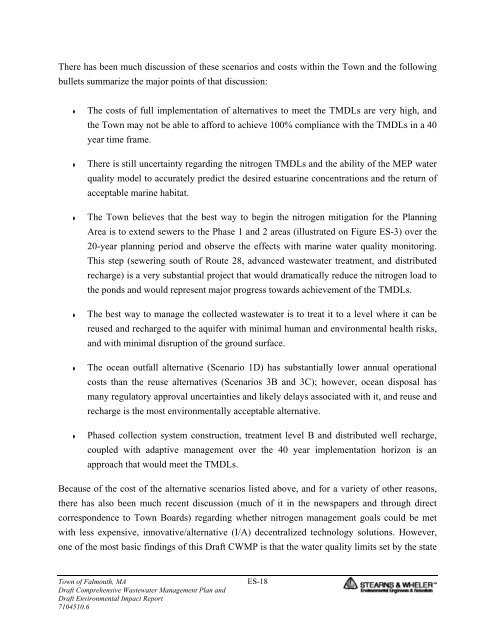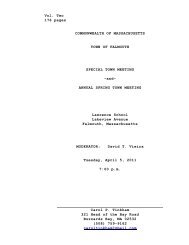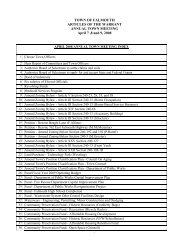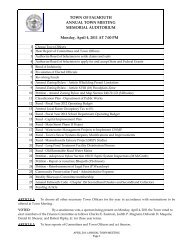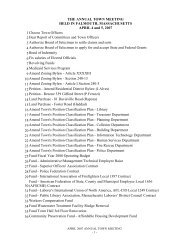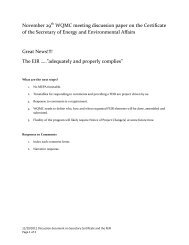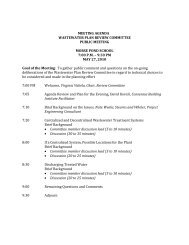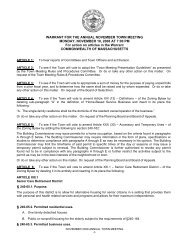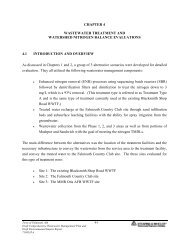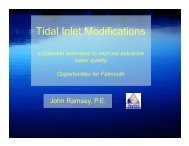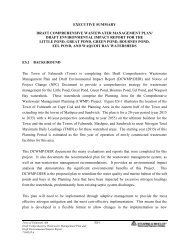EXECUTIVE SUMMARY (Without Figures) rev - Town of Falmouth
EXECUTIVE SUMMARY (Without Figures) rev - Town of Falmouth
EXECUTIVE SUMMARY (Without Figures) rev - Town of Falmouth
You also want an ePaper? Increase the reach of your titles
YUMPU automatically turns print PDFs into web optimized ePapers that Google loves.
There has been much discussion <strong>of</strong> these scenarios and costs within the <strong>Town</strong> and the following<br />
bullets summarize the major points <strong>of</strong> that discussion:<br />
The costs <strong>of</strong> full implementation <strong>of</strong> alternatives to meet the TMDLs are very high, and<br />
the <strong>Town</strong> may not be able to afford to achieve 100% compliance with the TMDLs in a 40<br />
year time frame.<br />
There is still uncertainty regarding the nitrogen TMDLs and the ability <strong>of</strong> the MEP water<br />
quality model to accurately predict the desired estuarine concentrations and the return <strong>of</strong><br />
acceptable marine habitat.<br />
The <strong>Town</strong> believes that the best way to begin the nitrogen mitigation for the Planning<br />
Area is to extend sewers to the Phase 1 and 2 areas (illustrated on Figure ES-3) over the<br />
20-year planning period and observe the effects with marine water quality monitoring.<br />
This step (sewering south <strong>of</strong> Route 28, advanced wastewater treatment, and distributed<br />
recharge) is a very substantial project that would dramatically reduce the nitrogen load to<br />
the ponds and would represent major progress towards achievement <strong>of</strong> the TMDLs.<br />
The best way to manage the collected wastewater is to treat it to a level where it can be<br />
reused and recharged to the aquifer with minimal human and environmental health risks,<br />
and with minimal disruption <strong>of</strong> the ground surface.<br />
The ocean outfall alternative (Scenario 1D) has substantially lower annual operational<br />
costs than the reuse alternatives (Scenarios 3B and 3C); however, ocean disposal has<br />
many regulatory approval uncertainties and likely delays associated with it, and reuse and<br />
recharge is the most environmentally acceptable alternative.<br />
Phased collection system construction, treatment level B and distributed well recharge,<br />
coupled with adaptive management over the 40 year implementation horizon is an<br />
approach that would meet the TMDLs.<br />
Because <strong>of</strong> the cost <strong>of</strong> the alternative scenarios listed above, and for a variety <strong>of</strong> other reasons,<br />
there has also been much recent discussion (much <strong>of</strong> it in the newspapers and through direct<br />
correspondence to <strong>Town</strong> Boards) regarding whether nitrogen management goals could be met<br />
with less expensive, innovative/alternative (I/A) decentralized technology solutions. However,<br />
one <strong>of</strong> the most basic findings <strong>of</strong> this Draft CWMP is that the water quality limits set by the state<br />
<strong>Town</strong> <strong>of</strong> <strong>Falmouth</strong>, MA ES-18<br />
Draft Comprehensive Wastewater Management Plan and<br />
Draft Environmental Impact Report<br />
7104510.6


